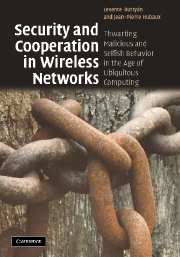 Security and Cooperation in Wireless Networks
Security and Cooperation in Wireless Networks Book contents
- Frontmatter
- Contents
- Preface
- Acknowledgements
- Part I Introduction
- 1 The security of existing wireless networks
- 2 Upcoming wireless networks and new challenges
- 3 Trust assumptions and adversary models
- Part II Thwarting malicious behavior
- Part III Thwarting selfish behavior
- Appendix A Introduction to cryptographic algorithms and protocols
- Appendix B A tutorial on game theory for wireless networks
- References
- Index
3 - Trust assumptions and adversary models
from Part I - Introduction
Published online by Cambridge University Press: 05 June 2012
- Frontmatter
- Contents
- Preface
- Acknowledgements
- Part I Introduction
- 1 The security of existing wireless networks
- 2 Upcoming wireless networks and new challenges
- 3 Trust assumptions and adversary models
- Part II Thwarting malicious behavior
- Part III Thwarting selfish behavior
- Appendix A Introduction to cryptographic algorithms and protocols
- Appendix B A tutorial on game theory for wireless networks
- References
- Index
Summary
Before diving into the mechanisms of malice and selfishness prevention, which will be the topic of the rest of this book, we will now focus on the notion of trust and we will refine the definition of the adversary model.
About trust
As we have already hinted in the previous chapter, building and maintaining trust will be much more difficult in upcoming wireless networks than in existing ones. Yet, trust is absolutely fundamental for the future of (wireless) communications. Once computing has become ubiquitous, it will probably be de facto mandatory, as are already today mobile phones and personal computers; but what if it is not trustworthy? What if it is as unsafe as today's Internet? Moreover, no business is possible without trust, and wireless networks are essentially driven by business considerations.
Trust can be defined as the belief that another party (a person, an organization, but also a device) will behave according to a set of well-established rules and will thus meet one's expectations. This notion is fundamental in all human societies (and also in many animal groups); generally, a breach of trust is considered to be a major offense.
But trust is a fuzzy notion, be it considered across persons or across areas of competence: no matter how close they are to each other, different people may trust very different things, even in front of the same evidence.
- Type
- Chapter
- Information
- Security and Cooperation in Wireless NetworksThwarting Malicious and Selfish Behavior in the Age of Ubiquitous Computing, pp. 74 - 82Publisher: Cambridge University PressPrint publication year: 2007
- 1
- Cited by


